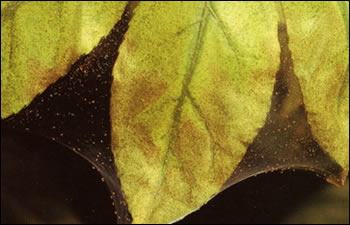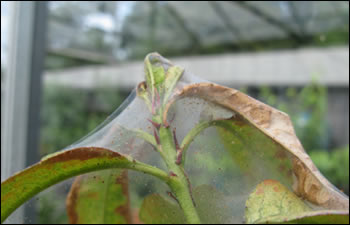SPIDER MITES
Red spider mite can be one of the most troublesome especially in greenhouses. They can also attack garden plants in summer. It is a sap-sucking mite that attacks the foliage of plants, causing a mottled appearance and in severe cases, leaf loss and plant death.
Red spider mite thrives in warm, dry conditions, and is usually a problem from March to October.
You may see the following symptoms:
- On leaves: Plants with glasshouse red spider mite show a fine pale mottling on the upper leaf surface. The underside of the leaves have many tiny yellowish green mites and white cast skins and egg shells. These are more easily seen with the aid of a x10 hand lens
- On plants: In heavy attacks, a fine, silk webbing may be seen on the plants and the leaves can lose most of their green colour and dry up or fall off. Heavily damaged plants can be severely weakened and may die




Control
Red spider mite can be difficult to control as they breed rapidly in warm conditions and some strains of the mite are resistant to some pesticides. Biological control is an alternative to using pesticides; it can give good control and as it avoids resistance problems and the risk of spray damage to plants.
Persist with ‘Malathion’ and insecticidal soaps at least three times at five day intervals.
Plants grown at high temperatures in glasshouses are more liable to damage and severe infestation. Regular syringing and spraying of plants with water and maintaining a high humidity reduce the risk, but will not, on its own control this mite.
Remove severely infested plants, especially in late summer before lower temperatures and shorter days induce the females to seek sheltered places where they will remain dormant for the winter period. To reduce overwintering mites to a minimum, clear out plant debris, old canes, stakes and plant-ties before the spring. Empty glasshouses can be cleaned thoroughly with a glasshouse disinfectant. Weeds in and around the glasshouse can be kept in check as these may act as hosts for the mite.
Plant Invigorator can be used to keep mite numbers in check. The systemic pesticide Bug Clear Ultra is available for use. Check the label for details and ensure that instructions are followed regarding maximum number of applications
Despite the name, during the spring and summer red spider mites are yellowish-green with a pair of darker markings. They only become orange-red during the autumn and winter resting period. The mites are small, up to 1mm (less than 1/16in) long, and are just visible to the naked eye, when present in large numbers. They are usually found on the lower leaf surface, along with their spherical eggs.